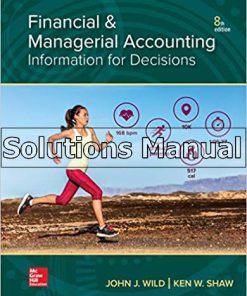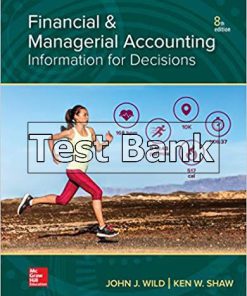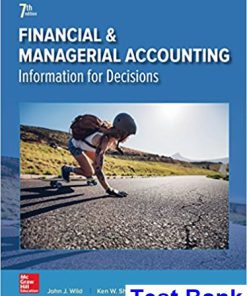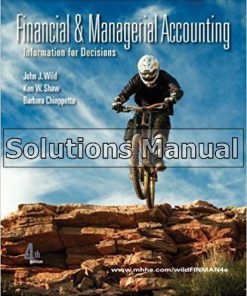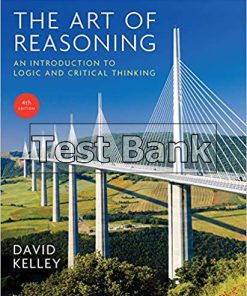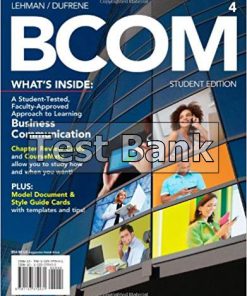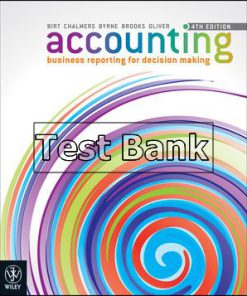Financial and Managerial Accounting 4th Edition Wild Test Bank
You may also like
-
$26.50
$50.00
Financial and Managerial Accounting 4th Edition Wild Test Bank
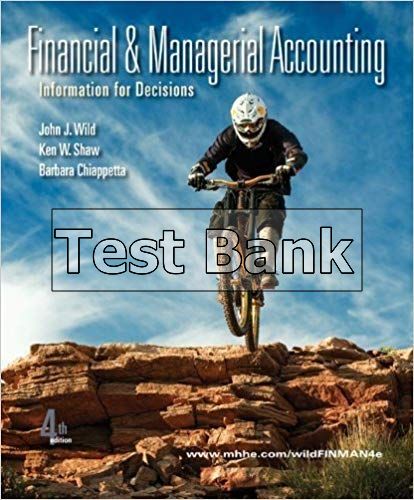
Product details:
- ISBN-10 : 0078110882
- ISBN-13 : 978-0078110887
- Author: John J. Wild
Wilds Financial and Managerial Accounting responds to the markets request for a single book with balanced financial and managerial content (~50/50) that has a corporate approach throughout. With numerous innovative features, the authors focus on Three Cs:
- Clear presentation of accounting concepts,
- Concise coverage to help students focus on important material, and
- Cutting-edge technology to engage students and improve their chances for success. The authors provide a balance of small and large business examples, integration of new computerized learning tools, superior end-of-chapter materials, and highly engaging pedagogical learning structures. Technology tools, such as Connect and Carol Yacht General Ledger and Peachtree software, provide students with further advantages as they learn, as well as apply, key accounting concepts and methods.
Table contents:
1 Accounting in Action 1-1
Knowing the Numbers: Columbia Sportswear 1-1
Accounting Activities and Users 1-3
Three Activities 1-3
Who Uses Accounting Data 1-4
The Building Blocks of Accounting 1-6
Ethics in Financial Reporting 1-6
Generally Accepted Accounting Principles 1-8
Measurement Principles 1-8
Assumptions 1-9
The Accounting Equation 1-11
Assets 1-11
Liabilities 1-12
Stockholders’ Equity 1-12
Analyzing Business Transactions 1-13
Accounting Transactions 1-14
Transaction Analysis 1-15
Summary of Transactions 1-19
The Financial Statements 1-21
Income Statement 1-21
Retained Earnings Statement 1-23
Balance Sheet 1-23
Statement of Cash Flows 1-23
Appendix 1A: Career Opportunities in Accounting 1-25
Public Accounting 1-25
Private Accounting 1-25
Governmental Accounting 1-26
Forensic Accounting 1-26
“Show Me the Money” 1-26
2 The Recording Process 2-1
Accidents Happen: MF Global Holdings 2-1
Accounts, Debits, and Credits 2-3
Debits and Credits 2-3
Stockholders’ Equity Relationships 2-7
Summary of Debit/Credit Rules 2-7
The Journal 2-8
The Recording Process 2-8
The Journal 2-9
The Ledger and Posting 2-11
The Ledger 2-11
Posting 2-12
Chart of Accounts 2-13
The Recording Process Illustrated 2-14
Summary Illustration of Journalizing and Posting 2-20
The Trial Balance 2-22
Limitations of a Trial Balance 2-23
Locating Errors 2-23
Dollar Signs and Underlining 2-23
3 Adjusting the Accounts 3-1
Keeping Track of Groupons: Groupon 3-1
Accrual-Basis Accounting and Adjusting Entries 3-2
Fiscal and Calendar Years 3-3
Accrual- versus Cash-Basis Accounting 3-3
Recognizing Revenues and Expenses 3-3
The Need for Adjusting Entries 3-5
Types of Adjusting Entries 3-6
Adjusting Entries for Deferrals 3-7
Prepaid Expenses 3-7
Unearned Revenues 3-11
Adjusting Entries for Accruals 3-14
Accrued Revenues 3-14
Accrued Expenses 3-15
Summary of Basic Relationships 3-18
Adjusted Trial Balance and Financial Statements 3-21
Preparing the Adjusted Trial Balance 3-22
Preparing Financial Statements 3-22
Appendix 3A: Adjusting Entries for the Alternative Treatment of Deferrals 3-25
Prepaid Expenses 3-26
Unearned Revenues 3-27
Summary of Additional Adjustment Relationships 3-28
Appendix 3B: Financial Reporting Concepts 3-28
Qualities of Useful Information 3-28
Assumptions in Financial Reporting 3-29
Principles in Financial Reporting 3-29
Cost Constraint 3-31
4 Completing the Accounting Cycle 4-1
Everyone Likes to Win: Rhino Foods 4-1
The Worksheet 4-3
Steps in Preparing a Worksheet 4-3
Preparing Financial Statements from a Worksheet 4-7
Preparing Adjusting Entries from a Worksheet 4-8
Closing the Books 4-8
Preparing Closing Entries 4-9
Posting Closing Entries 4-11
Preparing a Post-Closing Trial Balance 4-12
The Accounting Cycle and Correcting Entries 4-15
Summary of the Accounting Cycle 4-15
Reversing Entries—An Optional Step 4-15
Correcting Entries—An Avoidable Step 4-15
Classified Balance Sheet 4-18
Current Assets 4-20
Long-Term Investments 4-20
Property, Plant, and Equipment 4-20
Intangible Assets 4-21
Current Liabilities 4-22
Long-Term Liabilities 4-23
Stockholders’ (Owners’) Equity 4-23
Appendix 4A: Reversing Entries 4-24
Reversing Entries Example 4-25
5 Accounting for Merchandising Operations 5-1
Buy Now, Vote Later: REI 5-1
Merchandising Operations and Inventory Systems 5-3
Operating Cycles 5-3
Flow of Costs 5-4
Recording Purchases Under a Perpetual System 5-6
Freight Costs 5-8
Purchase Returns and Allowances 5-9
Purchase Discounts 5-9
Summary of Purchasing Transactions 5-10
Recording Sales Under a Perpetual System 5-11
Sales Returns and Allowances 5-12
Sales Discounts 5-13
Data Analytics and Credit Sales 5-14
The Accounting Cycle for a Merchandising Company 5-15
Adjusting Entries 5-15
Closing Entries 5-16
Summary of Merchandising Entries 5-16
Multiple-Step Income Statement 5-18
Multiple-Step Income Statement 5-18
Single-Step Income Statement 5-21
Classified Balance Sheet 5-21
Appendix 5A: Merchandising Company Worksheet 5-23
Using a Worksheet 5-23
Appendix 5B: Periodic Inventory System 5-24
Determining Cost of Goods Sold Under a Periodic System 5-25
Recording Merchandise Transactions 5-26
Recording Purchases of Merchandise 5-26
Recording Sales of Merchandise 5-27
Journalizing and Posting Closing Entries 5-28
Using a Worksheet 5-29
6 Inventories 6-1
“Where Is That Spare Bulldozer Blade?”: Caterpillar 6-1
Classifying and Determining Inventory 6-2
Classifying Inventory 6-3
Determining Inventory Quantities 6-4
Inventory Methods and Financial Effects 6-7
Specific Identification 6-7
Cost Flow Assumptions 6-8
Financial Statement and Tax Effects of Cost Flow Methods 6-13
Using Inventory Cost Flow Methods Consistently 6-15
Effects of Inventory Errors 6-16
Income Statement Effects 6-17
Balance Sheet Effects 6-18
Inventory Presentation and Analysis 6-18
Presentation 6-18
Lower-of-Cost-or-Net Realizable Value 6-19
Analysis 6-20
Appendix 6A: Inventory Cost Flow Methods in Perpetual Inventory Systems 6-22
First-In, First-Out (FIFO) 6-22
Last-In, First-Out (LIFO) 6-23
Average-Cost 6-23
Appendix 6B: Estimating Inventories 6-24
Gross Profit Method 6-24
Retail Inventory Method 6-25
Data Analytics in Action 6-47
7 Fraud, Internal Control, and Cash 7-1
Minding the Money in Madison: Barriques 7-2
Fraud and Internal Control 7-3
Fraud 7-3
The Sarbanes-Oxley Act 7-3
Internal Control 7-4
Principles of Internal Control Activities 7-4
Data Analytics and Internal Controls 7-10
Limitations of Internal Control 7-11
Cash Controls 7-12
Cash Receipts Controls 7-12
Cash Disbursements Controls 7-15
Petty Cash Fund 7-16
Control Features of a Bank Account 7-19
Making Bank Deposits 7-19
Writing Checks 7-20
Electronic Funds Transfer (EFT) System 7-21
Bank Statements 7-21
Reconciling the Bank Account 7-22
Reporting Cash 7-27
Cash Equivalents 7-27
Restricted Cash 7-28
Data Analytics in Action 7-46
8 Accounting for Receivables 8-1
What’s Cooking?: Nike 8-1
Recognition of Accounts Receivable 8-3
Types of Receivables 8-3
Recognizing Accounts Receivable 8-3
Valuation and Disposition of Accounts Receivable 8-5
Valuing Accounts Receivable 8-5
Disposing of Accounts Receivable 8-12
Notes Receivable 8-14
Determining the Maturity Date 8-15
Computing Interest 8-16
Recognizing Notes Receivable 8-16
Valuing Notes Receivable 8-16
Disposing of Notes Receivable 8-16
Presentation and Analysis of Receivables 8-19
Presentation 8-19
Analysis 8-20
Data Analytics and Receivables Management 8-21
9 Plant Assets, Natural Resources, and Intangible Assets 9-1
A Tale of Two Airlines: American Airlines 9-2
Plant Asset Expenditures 9-3
Determining the Cost of Plant Assets 9-3
Expenditures During Useful Life 9-5
Depreciation Methods 9-7
Factors in Computing Depreciation 9-8
Depreciation Methods 9-9
Depreciation and Income Taxes 9-14
Revising Periodic Depreciation 9-15
Impairments 9-16
Plant Asset Disposals 9-16
Sale of Plant Assets 9-17
Retirement of Plant Assets 9-18
Natural Resources and Intangible Assets 9-19
Natural Resources 9-19
Depletion 9-20
Intangible Assets 9-20
Accounting for Intangible Assets 9-21
Types of Intangible Assets 9-22
Research and Development Costs 9-23
Statement Presentation and Analysis 9-24
Presentation 9-24
Analysis 9-25
Appendix 9A: Exchange of Plant Assets 9-27
Loss Treatment 9-27
Gain Treatment 9-28
Data Analytics in Action 9-46
10 Liabilities 10-1
And Then There Were Two: Maxwell Car Company 10-1
Accounting for Current Liabilities 10-3
What Is a Current Liability? 10-3
Notes Payable 10-3
Sales Taxes Payable 10-4
Unearned Revenues 10-5
Current Maturities of Long-Term Debt 10-5
Payroll and Payroll Taxes Payable 10-6
Major Characteristics of Bonds 10-8
Types of Bonds 10-8
Issuing Procedures 10-9
Bond Trading 10-9
Determining the Market Price of a Bond 10-10
Accounting for Bond Transactions 10-12
Issuing Bonds at Face Value 10-13
Discount or Premium on Bonds 10-13
Issuing Bonds at a Discount 10-14
Issuing Bonds at a Premium 10-15
Redeeming Bonds at Maturity 10-17
Redeeming Bonds Before Maturity 10-17
Accounting for Long-Term Notes Payable 10-18
Mortgage Notes Payable 10-18
Lease Liabilities 10-19
Reporting and Analyzing Liabilities 10-21
Presentation 10-21
Analysis 10-21
Debt and Equity Financing 10-23
Appendix 10A: Straight-Line Amortization 10-25
Amortizing Bond Discount 10-25
Amortizing Bond Premium 10-26
Appendix 10B: Effective-Interest Amortization 10-27
Amortizing Bond Discount 10-28
Amortizing Bond Premium 10-29
11 Corporations: Organization, Stock Transactions, and Stockholders’ Equity 11-1
Oh Well, I Guess I’ll Get Rich: Facebook 11-2
Corporate Form of Organization 11-3
Characteristics of a Corporation 11-3
Forming a Corporation 11-6
Stockholder Rights 11-6
Stock Issue Considerations 11-8
Corporate Capital 11-10
Accounting for Stock Issuances 11-11
Accounting for Common Stock 11-11
Accounting for Preferred Stock 11-14
Accounting for Treasury Stock 11-15
Cash Dividends, Stock Dividends, and Stock Splits 11-18
Cash Dividends 11-19
Dividend Preferences 11-21
Stock Dividends 11-23
Stock Splits 11-25
Reporting and Analyzing Stockholders’ Equity 11-27
Retained Earnings 11-27
Retained Earnings Restrictions 11-28
Balance Sheet Presentation of Stockholders’ Equity 11-29
Analysis of Stockholders’ Equity 11-30
Appendix 11A: Stockholders’ Equity Statement 11-32
Appendix 11B: Book Value per Share 11-33
Book Value per Share Example 11-33
Book Value versus Market Price 11-34
Data Analytics in Action 11-55
12 Statement of Cash Flows 12-1
Got Cash?: Microsoft 12-2
Usefulness and Format of the Statement of Cash Flows 12-3
Usefulness of the Statement of Cash Flows 12-3
Classification of Cash Flows 12-3
Significant Noncash Activities 12-4
Format of the Statement of Cash Flows 12-5
Preparing the Statement of Cash Flows—Indirect Method 12-6
Indirect and Direct Methods 12-7
Indirect Method—Computer Services Company 12-7
Step 1: Operating Activities 12-9
Summary of Conversion to Net Cash Provided by Operating Activities—Indirect Method 12-12
Step 2: Investing and Financing Activities 12-13
Step 3: Net Change in Cash 12-15
Analyzing the Statement of Cash Flows 12-17
Free Cash Flow 12-17
Appendix 12A: Statement of Cash Flows—Direct Method 12-19
Step 1: Operating Activities 12-19
Step 2: Investing and Financing Activities 12-24
Step 3: Net Change in Cash 12-26
Appendix 12B: Worksheet for the Indirect Method 12-26
Preparing the Worksheet 12-27
Appendix 12C: Statement of Cash Flows—T-Account Approach 12-31
Data Analytics in Action 12-56
13 Financial Analysis: The Big Picture 13-1
It Pays to Be Patient: Warren Buffett 13-2
Sustainable Income and Quality of Earnings 13-3
Sustainable Income 13-3
Quality of Earnings 13-7
Horizontal Analysis and Vertical Analysis 13-9
Horizontal Analysis 13-10
Vertical Analysis 13-12
Ratio Analysis 13-15
Liquidity Ratios 13-16
Solvency Ratios 13-17
Profitability Ratios 13-17
Financial Analysis and Data Analytics 13-18
Comprehensive Example of Ratio Analysis 13-18
14 Managerial Accounting 14-1
Just Add Water . . . and Paddle: Current Designs 14-1
Managerial Accounting Basics 14-3
Comparing Managerial and Financial Accounting 14-3
Management Functions 14-4
Organizational Structure 14-5
Managerial Cost Concepts 14-7
Manufacturing Costs 14-8
Product versus Period Costs 14-9
Illustration of Cost Concepts 14-10
Manufacturing Costs in Financial Statements 14-12
Balance Sheet 14-12
Income Statement 14-13
Cost of Goods Manufactured 14-14
Cost of Goods Manufactured Schedule 14-15
Managerial Accounting Today 14-16
Service Industries 14-16
Focus on the Value Chain 14-17
Balanced Scorecard 14-19
Business Ethics 14-19
Corporate Social Responsibility 14-20
The Value of Data Analytics 14-20
Data Analytics Insight: Using Data in Its Own World 14-21
Data Analytics in Action 14-43
15 Job Order Costing 15-1
Profiting from the Silver Screen: Disney 15-1
Cost Accounting Systems 15-3
Process Cost System 15-3
Job Order Cost System 15-4
Data Analytics Insight: Providing Service Through the Cloud 15-4
Job Order Cost Flow 15-5
Accumulating Manufacturing Costs 15-5
Assigning Manufacturing Costs 15-7
Raw Materials Costs 15-8
Factory Labor Costs 15-10
Predetermined Overhead Rates 15-13
Entries for Jobs Completed and Sold 15-16
Assigning Costs to Finished Goods 15-17
Assigning Costs to Cost of Goods Sold 15-17
Summary of Job Order Cost Flows 15-18
Job Order Costing for Service Companies 15-19
Advantages and Disadvantages of Job
Order Costing 15-20
Applied Manufacturing Overhead 15-22
Under- or Overapplied Manufacturing Overhead 15-22
Data Analytics in Action 15-41
16 Process Costing 16-1
The Little Guy Who Could: Jones Soda 16-1
Overview of Process Cost Systems 16-3
Uses of Process Cost Systems 16-3
Process Costing for Service Companies 16-4
Similarities and Differences Between Job Order Cost and Process Cost Systems 16-4
Process Cost Flow and Assigning Costs 16-6
Process Cost Flow 16-6
Assigning Manufacturing Costs—Journal Entries 16-7
Equivalent Units 16-9
Weighted-Average Method 16-10
Refinements on the Weighted-Average Method 16-10
The Production Cost Report 16-13
Compute the Physical Unit Flow (Step 1) 16-14
Compute the Equivalent Units of Production (Step 2) 16-15
Compute Unit Production Costs (Step 3) 16-15
Prepare a Cost Reconciliation Schedule (Step 4) 16-16
Preparing the Production Cost Report 16-17
Costing Systems—Final Comments 16-18
Appendix 16A: FIFO Method for Equivalent Units 16-19
Equivalent Units Under FIFO 16-19
Comprehensive Example 16-20
FIFO and Weighted-Average 16-24
17 Activity-Based Costing 17-1
Precor Is on Your Side: Precor17-1
Traditional vs. Activity-Based Costing 17-3
Traditional Costing Systems 17-3
Illustration of a Traditional Costing System 17-3
The Need for a New Approach 17-4
Activity-Based Costing 17-5
ABC and Manufacturers 17-7
Identify and Classify Activities and Allocate Overhead to Cost Pools (Step 1) 17-8
Identify Cost Drivers (Step 2) 17-8
Compute Activity-Based Overhead Rates (Step 3) 17-9
Assign Overhead Costs to Products (Step 4) 17-10
Comparing Unit Costs 17-10
ABC Benefits and Limitations 17-13
The Advantage of Multiple Cost Pools 17-13
The Advantage of Enhanced Cost Control 17-15
The Advantage of Better Management Decisions 17-18
Some Limitations and Knowing When to Use ABC 17-18
Data Analytics Insight: Delivering People and Packages 17-19
ABC and Service Industries 17-20
Traditional Costing Example 17-20
Activity-Based Costing Example 17-21
Appendix 17A: Just-in-Time Processing 17-23
Objective of JIT Processing 17-24
Elements of JIT Processing 17-25
Benefits of JIT Processing 17-25
18 Cost-Volume-Profit 18-1
Don’t Worry—Just Get Big: Amazon.com 18-1
Cost Behavior Analysis 18-3
Variable Costs 18-3
Fixed Costs 18-4
Relevant Range 18-5
Mixed Costs 18-7
Mixed Costs Analysis 18-8
High-Low Method 18-8
Importance of Identifying Variable and Fixed Costs 18-10
Cost-Volume-Profit Analysis 18-11
Basic Components 18-11
CVP Income Statement 18-12
Break-Even Analysis 18-16
Mathematical Equation 18-16
Contribution Margin Techniques 18-17
Graphic Presentation 18-19
Target Net Income and Margin of Safety 18-20
Target Net Income 18-20
Margin of Safety 18-21
CVP and Data Analytics 18-22
Appendix 18A: Regression Analysis 18-23
Data Analytics in Action 18-44
19 Cost-Volume-Profit Analysis: Additional Issues 19-1
Not Even a Flood Could Stop It: Whole Foods Market 19-1
Basic CVP Concepts 19-3
Basic Concepts 19-3
CVP and Changes in the Business Environment 19-5
Sales Mix and Break-Even Sales 19-7
Break-Even Sales in Units 19-8
Data Analytics Insight: Taking No Chances with Its Profits 19-10
Break-Even Sales in Dollars 19-10
Sales Mix with Limited Resources 19-13
Operating Leverage and Profitability 19-15
Effect on Contribution Margin Ratio 19-16
Effect on Break-Even Point 19-17
Effect on Margin of Safety Ratio 19-17
Operating Leverage 19-17
Appendix 19A: Absorption Costing versus Variable Costing 19-19
Example Comparing Absorption Costing with Variable Costing 19-20
Net Income Effects 19-22
Decision-Making Concerns 19-27
Potential Advantages of Variable Costing 19-30
Data Analytics in Action 19-50
20 Incremental Analysis 20-1
Keeping It Clean: Method Products 20-1
Decision-Making and Incremental Analysis 20-3
Incremental Analysis Approach 20-3
How Incremental Analysis Works 20-4
Qualitative Factors 20-5
Relationship of Incremental Analysis and Activity-Based Costing 20-5
Types of Incremental Analysis 20-6
Special Orders 20-6
Make or Buy 20-8
Opportunity Cost 20-9
Sell or Process Further 20-11
Single-Product Case 20-11
Multiple-Product Case 20-12
Repair, Retain, or Replace Equipment 20-14
Eliminate Unprofitable Segment or Product 20-16
21 Pricing 21-1
They’ve Got Your Size—and Color: Zappos.com 21-1
Target Costing 21-3
Establishing a Target Cost 21-4
Cost-Plus and Variable-Cost Pricing 21-5
Cost-Plus Pricing 21-5
Limitations of Cost-Plus Pricing 21-7
Variable-Cost Pricing 21-8
Time-and-Material Pricing 21-10
Transfer Prices 21-13
Negotiated Transfer Prices 21-14
Cost-Based Transfer Prices 21-18
Market-Based Transfer Prices 21-19
Effect of Outsourcing on Transfer Pricing 21-19
Transfers Between Divisions in Different Countries 21-20
Data Analytics Insight: Setting the Optimal Price 21-20
Appendix 21A: Absorption-Cost and Variable-Cost Pricing 21-21
Absorption-Cost Pricing 21-21
Variable-Cost Pricing 21-23
Appendix 21B: Transfers Between Divisions in Different Countries 21-25
Data Analytics in Action 21-43
22 Budgetary Planning 22-1
What’s in Your Cupcake?: Erin McKennaʼs Bakery NYC 22-1
Effective Budgeting and the Master Budget 22-3
Budgeting and Accounting 22-3
The Benefits of Budgeting 22-3
Essentials of Effective Budgeting 22-4
The Master Budget 22-7
Sales, Production, and Direct Materials Budgets 22-8
Sales Budget 22-8
Production Budget 22-10
Direct Materials Budget 22-10
Direct Labor, Manufacturing Overhead, and S&A Expense Budgets 22-14
Direct Labor Budget 22-14
Manufacturing Overhead Budget 22-15
Selling and Administrative Expense Budget 22-15
Budgeted Income Statement 22-16
Data Analytics Insight: That’s Some Tasty Data! 22-17
Cash Budget and Budgeted Balance Sheet 22-18
Cash Budget 22-18
Budgeted Balance Sheet 22-21
Budgeting in Nonmanufacturing Companies 22-23
Merchandisers 22-23
Service Companies 22-24
Not-for-Profit Organizations 22-25
Data Analytics in Action 22-47
23 Budgetary Control and Responsibility Accounting 23-1
Pumpkin Madeleines and a Movie: The Roxy Hotel Tribeca 23-1
Budgetary Control and Static Budget Reports 23-3
Budgetary Control 23-3
Static Budget Reports 23-4
Flexible Budget Reports 23-7
Why Flexible Budgets? 23-7
Developing the Flexible Budget 23-9
Flexible Budget—A Case Study 23-10
Flexible Budget Reports 23-12
Data Analytics Insight: These Forecasts Move with the Times! 23-13
Responsibility Accounting and Responsibility Centers 23-14
Controllable versus Noncontrollable Revenues and Costs 23-16
Principles of Performance Evaluation 23-16
Data Analytics Insight: Hitting the Road with Zero-Based Budgeting 23-18
Responsibility Reporting System 23-18
Types of Responsibility Centers 23-19
Investment Centers 23-24
Return on Investment (ROI) 23-24
Responsibility Report 23-25
Alternative Measures of ROI Inputs 23-26
Improving ROI 23-26
Appendix 23A: ROI vs. Residual Income 23-28
Residual Income Compared to ROI 23-29
Residual Income Weakness 23-30
Data Analytics in Action 23-50
24 Standard Costs and Balanced Scorecard 24-1
80,000 Different Caffeinated Combinations: Starbucks 24-2
Overview of Standard Costs 24-3
Distinguishing Between Standards and Budgets 24-4
Setting Standard Costs 24-4
Direct Materials Variances 24-8
Analyzing and Reporting Variances 24-8
Calculating Direct Materials Variances 24-10
Direct Labor and Manufacturing Overhead Variances 24-13
Direct Labor Variances 24-13
Data Analytics Insight: Speedy Data to the Rescue! 24-16
Manufacturing Overhead Variances 24-16
Variance Reports and Balanced Scorecards 24-18
Reporting Variances 24-18
Income Statement Presentation of Variances 24-19
Balanced Scorecard 24-20
Appendix 24A: Standard Cost Accounting System 24-23
Journal Entries 24-23
Ledger Accounts 24-24
Appendix 24B: Overhead Controllable and Volume Variances 24-25
Overhead Controllable Variance 24-25
Overhead Volume Variance 24-27
Data Analytics in Action 24-46
25 Planning for Capital Investments 25-1
Floating Hotels: Holland America Line 25-2
Capital Budgeting and Cash Payback 25-3
Cash Flow Information 25-3
Illustrative Data 25-4
Cash Payback 25-4
Net Present Value Method 25-6
Equal Annual Cash Flows 25-7
Unequal Annual Cash Flows 25-8
Choosing a Discount Rate 25-9
Simplifying Assumptions 25-10
Comprehensive Example 25-10
Capital Budgeting Challenges and Refinements 25-12
Intangible Benefits 25-12
Profitability Index for Mutually Exclusive Projects 25-14
Risk Analysis 25-15
Post-Audit of Investment Projects 25-16
Internal Rate of Return 25-17
Comparing Discounted Cash Flow Methods 25-18
Annual Rate of Return 25-20
Data Analytics Insight: Increasing the Chances of Gaming Wins 25-21
Data Analytics in Action 25-36
Appendix A Specimen Financial Statements: Apple Inc. A-1
Appendix B Specimen Financial Statements: PepsiCo, Inc. B-1
Appendix C Specimen Financial Statements: The Coca-Cola Company C-1
Appendix D Specimen Financial Statements: Amazon.com, Inc. D-1
Appendix E Specimen Financial Statements: Walmart Inc. E-1
Appendix F Specimen Financial Statements: Louis Vuitton F-1
Appendix G Time Value of Money G-1
Interest and Future Values G-2
Nature of Interest G-2
Future Value of a Single Amount G-3
Future Value of an Annuity G-5
Present Values G-7
Present Value Variables G-7
Present Value of a Single Amount G-8
Present Value of an Annuity G-10
Time Periods and Discounting G-12
Present Value of a Long-Term Note or Bond G-12
Capital Budgeting Situations G-15
Using Financial Calculators G-16
Present Value of a Single Sum G-17
Present Value of an Annuity G-18
Future Value of a Single Sum G-18
Future Value of an Annuity G-18
Internal Rate of Return G-19
Useful Applications of the Financial Calculator G-19
Appendix H Reporting and Analyzing Investments H-1
Accounting for Debt Investments H-1
Why Corporations Invest H-2
Accounting for Debt Investments H-3
Accounting for Stock Investments H-4
Holdings of Less Than 20% H-5
Holdings Between 20% and 50% H-6
Holdings of More Than 50% H-7
Reporting Investments in Financial Statements H-8
Debt Securities H-9
Equity Securities H-12
Balance Sheet Presentation H-12
Presentation of Realized and Unrealized Gain or Loss H-14
Company Index / Subject Index I-1
People also search:
financial and managerial accounting 4th edition solutions
financial and managerial accounting 4th edition wiley
financial and managerial accounting 4th edition pdf
financial and managerial accounting for decision makers 4th edition pdf
financial and managerial accounting for decision makers 4th edition


